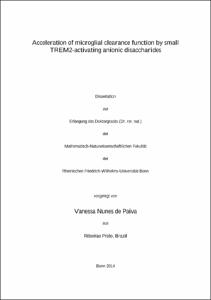Acceleration of microglial clearance function by small TREM2-activating anionic disaccharides

Acceleration of microglial clearance function by small TREM2-activating anionic disaccharides

| dc.contributor.advisor | Neumann, Harald | |
| dc.contributor.author | Nunes de Paiva, Vanessa | |
| dc.date.accessioned | 2020-04-20T00:12:23Z | |
| dc.date.available | 2020-04-20T00:12:23Z | |
| dc.date.issued | 29.07.2014 | |
| dc.identifier.uri | https://hdl.handle.net/20.500.11811/6131 | |
| dc.description.abstract | Triggering receptor expressed on myeloid cells-2 (TREM2) is an innate immune receptor, which is expressed on myeloid cells, like microglia inside the central nervous system. TREM2 signals via the adaptor protein DAP12. Previous studies have suggested that TREM2 plays a protective role in neuroinflammatory diseases. Activation of TREM2 increases phagocytosis and decreases pro-inflammatory microglial responses in vitro. However, the ligand which specifically binds to TREM2 is still unknown. Main objectives of this study were to find out structural elements recognized by TREM2 and to elucidate the effects of TREM2 ligand binding in microglia. To identify possible ligands for TREM2; human glioblastoma cells (U87), mouse glioma cells (GL261), small-cell lung carcinoma (SMA-560) and Chinese hamster ovary cells (CHO) were incubated with a TREM2b-Fc-fusion protein. Binding of TREM2 to target cells was blocked with different polysaccharides. Binding strength under different conditions was analysed by flow cytometry. First, TREM2b-Fc-fusion protein bound CHO, GL261, SMA-MS and U87 cells. Furthermore, these results show that the binding of the TREM2b-Fc fusion protein to U87 cells can be blocked at different efficiencies by the following glycosaminoglycans: dextran sulfate, chondroitin sulfatecontaining all subtypes of chondrotin suflates, chondroitin sulfate A (CS-A, chondroitin-4-sulfate), and adequan (polysulfated glycosaminoglycan), but not by chondroitin sulfate C (chondroitin-6-sulfate). As a control, U87 cells were pretreated with chondroitinase ABC. In line with the former results the binding of the TREM2b-Fc-fusion protein to the cells was reduced after removal of chondroitin sulfates from the glycocalyx of the target cells. These results confirm chondrotin suflates as ligands for TREM2 receptor. In contrast, pretreatment of U87 cells with sialidase (removal of sialic acids) did not change the binding of TREM2b-Fc-fusion protein. CS-A as an endogenous brain-derived molecule showed efficient binding and was selected as promising stimulating ligand for TREM2 in further experiments. Next, expression of TREM2 in a mouse microglia cell line was confirmed and the effects of CS-A and the core disaccharide unit of CS-A were analyzed. Treatment of TREM2 receptor expressing microglia with CS-A and the CS disaccharide stimulated phagocytosis of beads. On the other hand, the lentiviral knockdown of TREM2 in mouse microglia decreased the phagocytosis of beads after stimulation with 2 mM CS-A or 0.2 mM chondroitin sulfate disaccharides DS-4S. Stimulation of microglial cells with CS-A led to an up-regulation of pro-inflammatory cytokines (IL-1ß and TNF-α) and a down-regulation of iNOS. While stimulation of microglial cells with DS-4S led to a down-regulation of pro-inflammatory cytokines (IL-1ß, TNF-α and iNOS). In summary, these results suggest a new ligand for TREM2. Upon TREM2 stimulation by CS A or DS-4S, microglial cells are phagocytically activated. Taken together, these results suggest a protective role for TREM2 in the central nervous system. | en |
| dc.language.iso | eng | |
| dc.rights | In Copyright | |
| dc.rights.uri | http://rightsstatements.org/vocab/InC/1.0/ | |
| dc.subject.ddc | 570 Biowissenschaften, Biologie | |
| dc.subject.ddc | 610 Medizin, Gesundheit | |
| dc.title | Acceleration of microglial clearance function by small TREM2-activating anionic disaccharides | |
| dc.type | Dissertation oder Habilitation | |
| dc.publisher.name | Universitäts- und Landesbibliothek Bonn | |
| dc.publisher.location | Bonn | |
| dc.rights.accessRights | openAccess | |
| dc.identifier.urn | https://nbn-resolving.org/urn:nbn:de:hbz:5n-36850 | |
| ulbbn.pubtype | Erstveröffentlichung | |
| ulbbnediss.affiliation.name | Rheinische Friedrich-Wilhelms-Universität Bonn | |
| ulbbnediss.affiliation.location | Bonn | |
| ulbbnediss.thesis.level | Dissertation | |
| ulbbnediss.dissID | 3685 | |
| ulbbnediss.date.accepted | 03.07.2014 | |
| ulbbnediss.institute | Medizinische Fakultät / Institute : Institut für Rekonstruktive Neurobiologie (IRN) | |
| ulbbnediss.fakultaet | Mathematisch-Naturwissenschaftliche Fakultät | |
| dc.contributor.coReferee | Hoch, Michael |
Files in this item
This item appears in the following Collection(s)
-
E-Dissertationen (4378)




